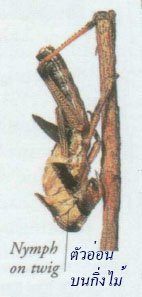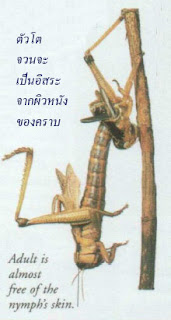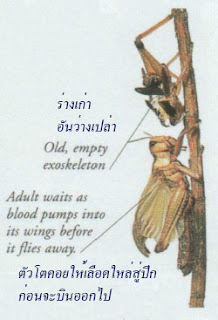ARTHROPODS
MORE THAN ONE
MILLION species of arthropod exist, making them the largest group in the animal kingdom. They live in almost all habitats, from
mountain tops to the ocean depths. Arthropods
are invertebrates - animals without backbones. They come in many shapes and sizes, from tiny mites to large crabs. Their
bodies are divided into segments, and they have distinct heads with antennae or eyes. Rigid
exoskeletons encase their bodies, but flexible leg
joints allow them to move around, and give
them their name.
|
สัตว์ขาปล้อง
สัตว์ขาปล้องมีอยู่มากกว่าหนึ่งล้านชนิด
เป็นกลุ่มใหญ่ที่สุดในอาณาจักรสัตว์ เกือบทั้งหมดมีถิ่นอาศัยตั้งแต่ยอดเขาจนถึงมหาสมุทรลึก
สัตว์ขาปล้องเป็นสัตว์ไม่มีกระดูกสันหลัง มีรูปร่างและขนาดมากมาย ตั้งแต่ตัวเห็บตัวไรเล็ก
ๆ จนถึงปูขนาดใหญ่ ร่างกายเป็นปล้องและมีศีรษะพร้อมทั้งหนวดและตาชัดเจน มีเปลือกด้านนอกแข็งห่อหุ้มร่างกาย แต่ข้อต่อขายืดหยุ่นช่วยให้สามารถเคลื่อนที่ไปรอบ
ๆ และตั้งชื่อให้กับพวกมัน
|
||||
Types
of arthropod
Arthropods vary in
size, from minute creatures a fraction of a millimetre
long to outsized sea dwellers several kilograms in weight. There are four main types of arthropod - insects, arachnids, crustaceans, and myriapods. Insects are the largest group, accounting for almost 90 per
cent of all arthropods.
|
ประเภทของสัตว์ขาปล้อง
สัตว์ขาปล้องมีขนาดแตกต่างกันออกไปตั้งแต่สัตว์มีชีวิตเล็ก
ๆ น้อย ๆ ยาวเป็นมิลลิเมตรจนถึงสัตว์ที่อาศัยอยู่ในทะเลขนาดใหญ่หลายกิโลกรัม สัตว์ขาปล้องมีประเภทหลัก
ๆ อยู่ 4 ชนิด คือ แมลง แมง ครัสเตเชียน (กุ้ง กั้ง ปู) และ สัตว์จำพวกตะขาบกิ้งกือ
(myriapod) แมลงเป็นกลุ่มที่ใหญ่ที่สุดโดยคิดเป็นเกือบร้อยละ 90 ของสัตว์ขาปล้องทั้งหมด
|
||||
Broad-bodied chaser dragonfly
แมงปอนักล่าลำตัวกว้าง
|
|||||
Arachnids
Arachnids
include spiders, scorpions, and mites. They
have eight legs; scorpions use the front pair as claws. Spiders and scorpions are carnivores
that live mainly on land. Spiders often
kill their prey with poisonous fangs; scorpions use
their venom-filled sting.
|
สัตว์จำพวกแมง
สัตว์จำพวกแมงประกอบด้วย
แมงมุม แมงป่อง และเห็บไร มี 8 ขา แมงป่องใช้ขาคู่หน้าเป็นก้าม แมงมุมและแมงป่องเป็นสัตว์กินเนื้อที่อาศัยอยู่บนบกเป็นหลัก
แมงมุมมักฆ่าเหยื่อด้วยเขี้ยวพิษ แมงป่องใช้เหล็กที่เต็มไปด้วยพิษฆ่าเหยื่อ
|
Insects
Insects
are the most diverse group of arthropods. They
live in all kinds of land and freshwater habitats. All adult insects have six legs, and
most have wings — they are the only
arthropods that can fly.
|
แมลง
แมลงเป็นกลุ่มสัตว์ขาปล้องที่มีความหลากหลายมากที่สุด
อาศัยอยู่ทุกพื้นที่ทั้งบนบกและในน้ำจืด แมลงตัวเต็มวัยมีขาหกขาและส่วนใหญ่มีปีก
เป็นสัตว์ปีขาปล้องพวกเดียวที่สามารถบินได้
|
||
Myriapods
Myriapods include millipedes and centipedes. They have more legs than other arthropods - as many as 200
in some species. Their bodies are
long and tubular. They live in the
soil or among leaf debris.
|
สัตว์จำพวกตะขาบกิ้งกือ
สัตว์จำพวกตะขาบกิ้งกือ
(Myriapod) ประกอบด้วยกิ้งกือและตะขาบ มีขามากกว่าสัตว์ขาปล้องชนิดอื่น
บางชนิดมีถึง 200 ขา มีร่างกายยาวและมีลักษณะเป็นหลอด อาศัยอยู่ในดินและอยู่ตามเศษซากใบไม้
|
Crustaceans
Crustaceans include
crabs, shrimps, and lobsters. Most
live in the sea or in freshwater and have five pairs of legs. Lobsters and crabs have very thick exoskeletons and some
grow extremely large.
|
ครัสเตเชียน (กุ้ง กั้ง
ปู)
ครัสเตเชียนประกอบด้วยปู
กุ้งและกั้ง ส่วนใหญ่อาศัยอยู่ในทะเลหรือน้ำจืดและมีขา 5 คู่ กั้งและปูมีเปลือกด้านนอกแข็งหนามากและบางชนิดก็มีขนาดใหญ่สุดขีด
|
|
Exoskeleton
The exoskeleton of
an arthropod is a tough outer layer
covering the entire body, including the
eyes, antennae, and legs. It
protects and supports the muscles and
soft organs within the body and helps to
retain moisture.
|
โครงร่างแข็งภายนอก (เปลือกแข็ง)
โครงร่างแข็งภายนอกของสัตว์ขอปล้องคือเปลือกชั้นนอกที่เหนียวซึ่งปกปิดทั้งร่างกาย
รวมทั้งดวงตา หนวดและขา ช่วยปกป้องและพยุงกล้ามเนื้อและอวัยวะอ่อนภายในร่างกายและช่วยรักษาความชื้น
|
||||
Moulting and growth
Exoskeletons are
fixed in size. In order to grow, an arthropod must shed, or moult, this rigid layer. Its
body then rapidly expands before a new exoskeleton
hardens in place of the old one. Moulting
is part of a process called "incomplete metamorphosis". This is where the
young, called nymphs, emerge from eggs looking like tiny
adults. They moult many times before reaching adult size. In "complete metamorphosis", the animal changes form as well
as size.
|
การลอกคราบและการเจริญเติบโต
โครงร่างแข็งภายนอกมีขนาดคงที่
เพื่อที่จะเติบโต สัตว์ขาปล้องต้องสลัดคราบหรือลอกคราบที่เป็นชั้นแข็งนี้ ครั้นแล้วร่างกายจะขยายตัวอย่างรวดเร็วก่อนที่จะมีโครงร่างแข็งภายนอกใหม่มาแทนที่ของเดิม
การลอกคราบเป็นส่วนหนึ่งของกระบวนการที่เรียกว่า "การเปลี่ยนแปลงรูปร่างที่ไม่สมบูรณ์"
ซึ่งเป็นที่ที่ตัวอ่อนโผล่ออกมาจากไข่มองดูคล้ายกับตัวโตที่เล็ก ๆ สัตว์ขาปล้องจะจะลอกคราบหลายครั้งก่อนที่จะตัวโต
ใน "การเปลี่ยนรูปร่างที่สมบูรณ์" สัตว์จะเปลี่ยนแปลงรูปร่างและขนาดด้วย
|
||||
Moulting/การลอกคราบ
1.
An emerging adult grasshopper has cracked
open its old exoskeleton and is starting
to wriggle its body free, headfirst. Before
this final moult,
the
nymph will already have been through four
previous moults.
1. ตั๊กแตนตัวโตที่กำลังโผล่ออกมากะเทาะโครงร่างแข็งอันเก่าและเริ่มกระดิกตัวให้เป็นอิสระ
โดยการเอาหัวลงมาก่อน ก่อนการลอกคราบครั้งสุดท้ายนี้ ตัวอ่อนจะผ่านการลอกคราบมาแล้ว
4 ครั้ง
|
2. The
adult has pulled its legs and most
of its body out of the old skin. It
is already expanding in size, now
that it is free from its confines.
2.
ตั๊กแตนตัวโตจะลากขาของมันและร่างกายส่วนใหญ่ออกมาจากผิวหนังอันเก่า ลำตัวขยายขนาด
ตอนนี้มันเป็นอิสระจากสถานที่กักขังแล้ว
Exoskeleton of a fiddler crab
โครงร่างของปูก้ามดาบ
|
3. Moulting
is now complete. The adult rests while its new exoskeleton hardens and
its wings unfurl. Its old exoskeleton, now empty and brittle, still clings to the twig.
3. การลอกคราบเสร็จสมบูรณ์แล้ว ตัวโตพักผ่อนในขณะที่โครงร่างใหม่ของมันแข็งและปีกของมันคลี่คลาย
โครงร่างเก่าของมันตอนนี้ว่างเปล่าและเปราะยังติดกับกิ่งไม้
|
|||
Reproduction
Breeding
habits are very diverse among arthropods. Fertilization may take place inside or outside the females body. Normally, eggs are laid; some are
guarded, others are hidden and left alone.
The young of some arthropods, such as garden
spiders, are tiny versions of adults called nymphs; others start life as larvae and look
different from the adults.
|
Cluster
of young garden spiders
กลุ่มแมงมุมสวนตัวเล็ก ๆ |
การขยายพันธุ์
พฤติกรรมการผสมพันธุ์มีความหลากหลายในหมู่สัตว์ขาปล้อง
การปฏิสนธิอาจเกิดขึ้นภายในหรือภายนอกร่างกายของตัวเมีย ปกติจะมีการวางไข่ ไข่บางชนิดจะได้รับการดูแล
บางชนิดจะถูกซ่อนไว้และทิ้งไว้ตามลำพัง ตัวอ่อนของสัตว์ขาปล้องขางชนิด เช่น แมงมุมสวน
จะเหมือนกับตัวโตที่ยังเล็ก ๆ อยู่ สัตว์ขาปล้องบางชนิดเริ่มมีชีวิตเป็นดักแด้และมองดูแตกต่างจากตัวโต
|
|||
Feeding
Arthropods feed on
all kinds of plant and animal matter, both living and
dead. Some arthropods, such as
praying mantises, have pincers to gather food; others
use their front legs. Many have
cutting and chewing mouthparts, while those that feed on fluids, such as true bugs, have
mouths modified for sucking. Small aquatic arthropods
eat by filtering food particles from water.
|
การกินอาหาร
สัตว์ขาปล้องจะกินพืชทุกชนิดและเนื้อสัตว์ทั้งที่เป็นและตายแล้วเป็นอาหาร
สัตว์ขาปล้องบางชนิด เช่น ตั๊กแตนตำข้าว จะมีปากคีบเพื่อจับอาหารกิน
บางชนิดใช้ขาหน้า สัตว์ขาปล้องหลายชนิด มีบริเวณปากสำหรับกัดและเคี้ยว
ในขณะบางชนิดจะกินของเหลวเป็นอาหาร เช่น แมลงเล็ก ๆ (หรือมวน) จะมีปากไว้สำหรับดูดน้ำ
สัตว์ขาปล้องที่อยู่ในน้ำจะกรองเศษธุลีอาหารจากน้ำเป็นอาหาร
|
|||||
|
Garden
spider feeding on a wasp
แมงมุมสวนกำลังกินตัวต่อเป็นอาหาร |
Field
chafer beetle
ด้วงนา |
|||||
Carnivores
Many arthropods feed
on other animals. Garden spiders, for example, feed
mainly on insects. Some meat eaters also eat dead animals
and are called scavengers. Sand crabs scavenge on dead birds
and other debris found on the beach and seabed.
|
กินเนื้อเป็นอาหาร
สัตว์ขาปล้องหลายชนิดกินสัตว์อื่น
ๆ เป็นอาหาร ตัวอย่างเช่น แมงมุมสวนจะกินแมลงเป็นหลัก สัตว์กินเนื้อบางชนิดยังกินเนื้อสัตว์ที่ตายแล้วเป็นอาหารด้วยและเรียกว่า
scavenger
(สัตว์ที่กินซากสัตว์อื่นเป็นอาหาร) ปูทรายจะกินซากนกที่ตายแล้วและเศษเนื้อสัตว์อื่น
ๆ ที่พบบนชายหาดและก้นทะเล
|
Herbivores
Some arthropods,
such as chafer beetles, eat only plant matter. Adults feed on stems, leaves, and buds,
while larvae eat plant roots.
|
สัตว์ที่กินพืชเป็นอาหาร
สัตว์ขาปล้องบางชนิด
เช่น ด้วง จะกินเฉพาะพืชเป็นอาหาร ตัวโตจะกินกิ่งก้าน ใบ และหน่อเป็นอาหาร
ในขณะที่ตัวอ่อนกินรากพืชเป็นอาหาร
|
|||
|
Defence
As arthropods are
generally small in size, they are the target for a great many predators. Their hard exoskeleton, which acts as a tiny suit
of armour, provides the first line of defence. Some arthropods, such as pill
millipedes, take a passive form of defence and roll up into a ball if danger threatens. Other
arthropods have special protective weapons; including stings and pincers. Many ant species have glands on their abdomens
from which they secrete formic acid to drive off enemies.
|
|
การป้องกันตัว
ปกติขณะที่สัตว์ขาปล้องยังมีขนาดเล็ก
จะเป็นเป้าหมายของนักล่าจำนวนมาก โครงร่างที่แข็งซึ่งทำหน้าหน้าที่เป็นเกราะชุดเล็ก
ๆ จะเป็นแนวป้องกันด่านแรก สัตว์ขาปล้องบางชนิด เช่น กิ้งกือกระสุนจะทำร่างกายอยู่เฉยเพื่อป้องกันตัวและม้วนเป็นลูกกลม
ๆ ถ้ามีอันตรายคุกคาม สัตว์ขาปล้องชนิดอื่นจะมีอาวุธป้องกันตัวเป็นพิเศษ
ประกอบด้วย เหล็กในและปากคีบหรือกล้าม สัตว์จำพวกมดจำนวนมากจะมีต่อมที่ส่วนท้องซึ่งซ่อนกรดฟอร์มิกไว้ขับไล่ศัตรู
|
|||
|
Stings and pincers
Some arthropods have
pincers and stings which they use to
defend themselves against attackers. Scorpions
also use their large pincers to
catch animals. They then
use their venom-filled stings to paralyze their prey.
|
Fat-tailed scorpion
แมงป่องหางอ้วน |
เหล็กในและปากคีบ
สัตว์ขาปล้องบางชนิด
มีปากคีบและเหล็กในใช้ป้องกันผู้โจมตีนให้กับตัวเอง
แมงป่องยังใช้ปากคีบขนาดใหญ่จับสัตว์เป็นอาหารด้วย นอกจากนั้นยังใช้เหล็กในที่เต็มไปด้วยพิษทำให้เหยื่อเป็นอัมพาต
|
|||












